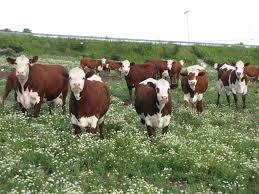
I found the grass-fed beef article in the April 2011 issue of ______ _____ magazine to be well researched and informative. Due to my meat related education and work experiences I can help explain some of the variability that was observed during your cooking tests. The primary subject was one side (half) of a Brangus cow carcass. Based on the hanging weight given, the live animal probably weighed about 1065 pounds (a fairly small beef animal). Knowing that you purchased a cow side helps explain why the resulting meat was somewhat dark in color and tough; both of those factors intensify with increasing animal age. The incidence of yellow tinted fat also increases in older bovines, in young grass-finished steers & heifers and sometimes results from cattle that lacked full liver function. The vast majority of retail beef cuts offered the US are either from steers or heifers. Some small volume grass-fed producers do sell bullocks because intact male cattle normally have a higher rate of weight gain. Meat from bullocks tends to be darker colored and tougher than that from steers & heifers.
Brahman cattle are more heat tolerant and disease resistant than European cattle breeds . Unfortunately, both Brahman and Brahman influence cattle (sometimes referred to as South cattle in the US) have a low propensity to marble and their lean is comparatively tough. Further, cattle with Brahman genetics, like your Brangus cow, are slow maturing i.e. older/tougher by the time slaughter weights are achieved.
USDA Meat Inspection is to assure the wholesomeness of meat and meat products. USDA Meat Grading is a voluntary service to evaluate carcass quality and/or expected meat yield, or to certify that meat and meat products are fabricated or processed to contracted specification. Graders are an unbiased third party employed to facilitate the meat marketing process.
Limousin beef cattle are a moderately early maturing Continental European breed that routinely produces slightly lager than average loin-eyes (based on carcass weights), has a low propensity to marble and is known to be relatively tender. Steaks from Limousin retail market aged cattle can be expected to be lean heart healthy cuts. I would not recommend cooking such steaks past medium-rare because they will rapidly dry out during high and dry heat cookery.
I am always trying to develop lean value-added products from underutilized pork and beef wholesale cuts. Feel free to consult me about meat articles.
